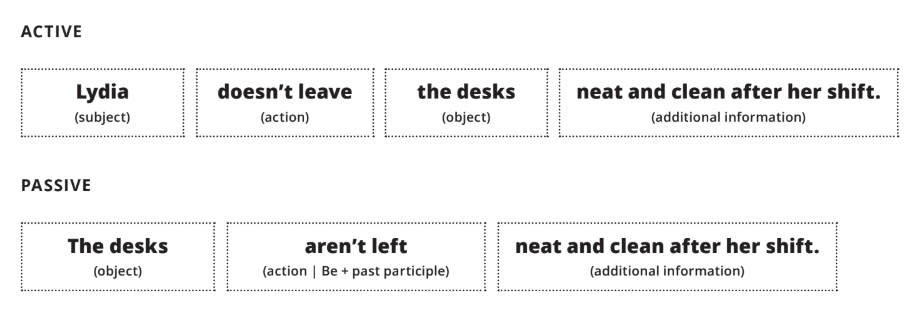Giving Feedback
In this lesson, you will learn useful vocabulary and expressions that you can use in giving feedback. The more you practice, the more comfortable you will feel on your skills!

Part 1
Warm-Up
Work with your teacher. Discuss the questions.
Topic 1: Feedback
How do you feel about giving and receiving feedback at work?
How often do you give and receive feedback?
What’s your style like when you give feedback? Are you direct, indirect, or both? Give examples.
Topic 2: Environmental Policy in the Workplace
Does your company have an environmental policy?
What do you think should be included in a workplace environmental policy?
Are there any “green initiatives” in your workplace?
Which of these environmental issues would be a priority to address in your workplace?
Explain your answer.
- Minimizing waste
- Recycling
- Efficient use of energy
- Efficient use of water
- Ride-sharing
- Reducing noise pollution
Part 2
Vocabulary Preview
Match the words or phrases with their correct meaning.
promotion ___
to teach and guide a worker
responsibilities ___
an increase in wages or salary
train ___
a higher-paying and/or more advanced position at one’s workplace
procedure ___
trustworthy
reliable ___
with agreement, without being forced
raise ___
work duties
willing ___
to act as a substitute for someone who is unavailable
cover ___
the times when you are able to work
cover ___
a series of actions conducted in a certain order or manner to achieve a result
cover ___
a meeting or report where an employee’s work achievements and progress are evaluated by a manager or supervisor
Complete each dialogue with a phrase from Vocabulary Preview A.
You may need to change some word forms.
Then practice each dialogue with a partner.
A: I don’t think changing our company’s approach to recycling is a priority right now.
B: I agree, but it could be something to consider __________
A: How did the marketing department react to your ideas?
B: I’d say reactions were mixed. Some people were positive, but not everyone __________ my suggestions.
A: I’m not sure how to structure this presentation effectively.
B: Okay. Well, do you want to __________ it together? That might help.
A: The latest sales figures were really disappointing. In all honesty, I don’t know how the company can keep going.
B: I know. It has __________ for me—there will definitely be layoffs this year.
A: I don’t think it’s that easy to implement the changes Carlos mentioned.
B: I know. It’s one thing suggesting changes like that. It’s another thing being able to __________.
A: Do you really think we need to change much of the company’s environmental policy?
B: Personally, I don’t think we need to change anything. We should just __________ the existing policy.
A: I don’t think the presentation was as bad as you say. You got the main message across, and most people seemed engaged.
B: Thanks! You always manage to __________ things.
A: I think we need more examples of how we can actually implement a new environmental policy.
B: You’re right. We need to __________ the point that people need to take action.
Part 3
Listening
Listen to the conversation between Kirsten and Daniel.
Answer the following questions.
What would Kirsten like to discuss?
Is Kirsten’s feedback mostly positive or mostly negative?
Listen to the conversation again.
Make notes in the chart based on Kirsten’s feedback.
| Praise | Suggestions for improvement |
Part 4
Language Functions
Look at the four language functions in the chart. Add each sentence from the box below to the chart based on its function. Some examples have been given.
Sentences:
• That’s good to hear. Thanks.
• It would be good to mention…
• I like the way…
• I really think…will…
• There are a couple of things I think we could add.
• Okay. What do you suggest?
• Thanks. I’m glad you’re happy with it.
• I think…is really [positive adjective].
• Can we just mention…
• What do you think we should include?
• I just feel…would help.
• What do you think?
• Just one more thing.
• Ah. Good point!
• Hmmm…I see your point.
• Keep up the good work!
• Good job on that.
• I really like…
• I agree.
• One final thing.
• You’ve done a really nice job.
• Again, great job on that.
• Could we add…?
| 1. Sharing positive feedback and praise |
| • You’ve done a really nice job. |
| 2. Suggesting areas for improvement |
| 3. Responding to feedback |
| • Ah. Good point! |
| 4. Encouraging others to share ideas |
Listen to the recording of the following questions and statements. What do you notice about the speaker’s voice? Does it go up or down?
Listen again and repeat.
Could you give a few examples?
Can we mention a few positive things?
It would be useful to add a few details.
There are a couple of things I think we could do differently.
I just feel a visual would help illustrate your point.
Just one more thing.
Part 5
Grammar Review
PASSIVE VOICE
We often use the passive voice when we want to emphasize the action over the person doing the action. The passive voice creates a sense of emotional distance and anonymity, which is especially important if you want to avoid blaming someone for a “wrong” action.
To change an active sentence to the passive, follow these steps:
• Make the recipient of the action the subject.
• Use the Be verb plus a past participle.

Change the sentences from active to passive. Avoid mentioning who does the action.
| Active form | Passive form |
| Roberto doesn’t always turn off the office lights when he leaves the building at the end of the day. | The office lights aren’t always turned off at the end of the day. |
| Most employees don’t display their staff parking permits in the front window of their car. | |
| Sarah and Eliza take too many smoking breaks. | |
| Everyone on the evening shift submits their monthly expense claims late. |
Part 5
Role-play
Students A & B
You are both graphic designers for a new company called Green Office Supplies. The company sells general office supplies including stationery, storage bins, first-aid supplies, and common office equipment such as paper shredders and water coolers. The company hopes their eco-friendly
products will be a big selling point. All their stationery supplies are made from recycled materials.
The manager has asked you to design a company logo and has given some guidance on the logo design:
• The logo must include the full company name.
• It must also include the company slogan: “Eco-friendly. Every day.”
• You should choose a typical piece of office equipment or stationery to
include in the logo.
• You should emphasize the company’s use of recycled
materials if possible.
1. You have five minutes. Brainstorm ideas together and then create a quick sketch of your logo. Don’t worry—things don’t have to be perfect.
2. Listen to the feedback from your manager. Make changes to your
design based on the feedback.
3. Share your new design with the manager. Listen to their feedback.
Do they feel the new design is an improvement?
Student C
You are the manager for a new company called Green Office Supplies. The company sells general office supplies including stationery, storage bins, first-aid supplies, and common office equipment such as paper shredders
and water coolers. The company hopes their eco-friendly products will be a big selling point. All their stationery supplies are made from recycled materials.
You have asked your graphic designers to create a new company logo. Here is the guidance you gave to help them on the logo design:
• The logo must include the full company name.
• It must also include the company slogan: “Eco-friendly. Every day.”
• You should choose a typical piece of office stationery to
include in the logo.
• You should emphasize the connection with recycled
materials if possible.
1. Your designers have five minutes to create their design.
2. Be ready to offer them feedback (both praise and
areas for improvement).
3. You should review the expressions from the Language Functions section in this lesson to help you prepare. Consider how these phrases might change when talking about a logo compared to presentation slides.
After completing Task 1, discuss these questions.
Designers: How clear was your manager’s feedback? Do you think the feedback was fair?
Managers: How well did your designers respond to feedback? How comfortable did you feel giving feedback?
Part 6
Transcripts
Transcripts for Listening 1, 2.
Kristen: Hi, Daniel. Do you have a minute?
Daniel: Sure.
Kristen: I’ve had a chance to look over the slides for next week’s presentation on the company’s new environmental policy. I have a few suggestions to make, if that’s okay?
Daniel: Of course. Give me just a second, I’m going to load the slides up on my screen so we can talk through them.
Kristen: Great.
Daniel: Here they are.
Kristen: Okay. So, first of all, I really like the overall approach you’ve taken. I think the presentation is very well structured. I like the way you’ve used visuals to highlight our concerns and priorities, especially the photos of plastic waste around the office and the picture of our office lit up like a Christmas tree after work hours. I really think these images will hit home for some of our staff. They certainly did for me, so good job on that.
Daniel: Thanks. I’m glad you’re happy with it. Yeah, I thought those visuals would help us make our point.
Kristen: Absolutely. Plus, you’ve included a lot of details on the changes we plan to make in the coming months. This is great since we want to implement this new policy as soon as possible. The other regional managers will certainly have a better idea of how we plan to put everything into practice. Again, great job on that.
Daniel: That’s good to hear. Thanks.
Kristen: There are a couple of things I think we could add to really drive home the message of collective responsibility. We want all staff members to be on board with this new policy.
Daniel: Okay. What do you suggest?
Kristen: It would be good to mention some of the positive things we already do as a company to help the environment. I know some employees would appreciate that. We don’t want the tone to be too negative.
Daniel: Hmm…I see your point. What do you think we should include?
Kristen: Well, it’s certainly worth mentioning the ride-sharing initiative—the minivan pickups have been very popular. What do you think?
Daniel: Of course! The RSI. I meant to include that. I’ll add a slide about it. Oh, and perhaps we should mention the community project from last year?
Kristen: Definitely. Sylvia took lots of photos of the tree-planting event, so maybe ask her for some of them. I just feel that putting a positive spin on things at the start of the presentation would help.
Daniel: I agree. I’ll change the beginning and send you the updated slides.
Kristen: Perfect. Just one more thing. Ah, two things actually. One is just a minor tweak.
Daniel: Okay.
Kristen: I know you mentioned the UN Sustainable Development Goals in the actual policy document. Can we just mention them somewhere in the presentation as well?
Daniel: Sure. Do you mean instead of mentioning the government’s new green proposals?
Kristen: Um, I think that would be better. You don’t have to go into too much detail. Just state our commitment to the SDGs since we are a global company. The latest government proposals at the national level are, well, just that—proposals. Nothing is confirmed yet. So, let’s just stick with the Sustainable Development Goals. People will be more familiar with them, and…
Daniel: They’re less controversial?
Kristen: I think so.
Daniel: And we can always add the proposals to the policy document down the line if we need to.
Kristen: Great. One final thing.
Daniel: Alright.
Kristen: The bulleted list of changes at the end of the presentation.
Daniel: Wait…this one?
Kristen: That’s it. Could we add an expected time frame for those changes to be implemented?
Daniel: Ah. Good point! Sure, will do. So, start with some positives, mention the UN Sustainable Development Goals, and…
Kristen: The time frame for changes.
Daniel: The time frame. Got it. Thanks for looking over these slides.
Kristen: Not at all. You’ve done a really nice job. We’re almost there. Keep up the good work!
Daniel: Thanks!
